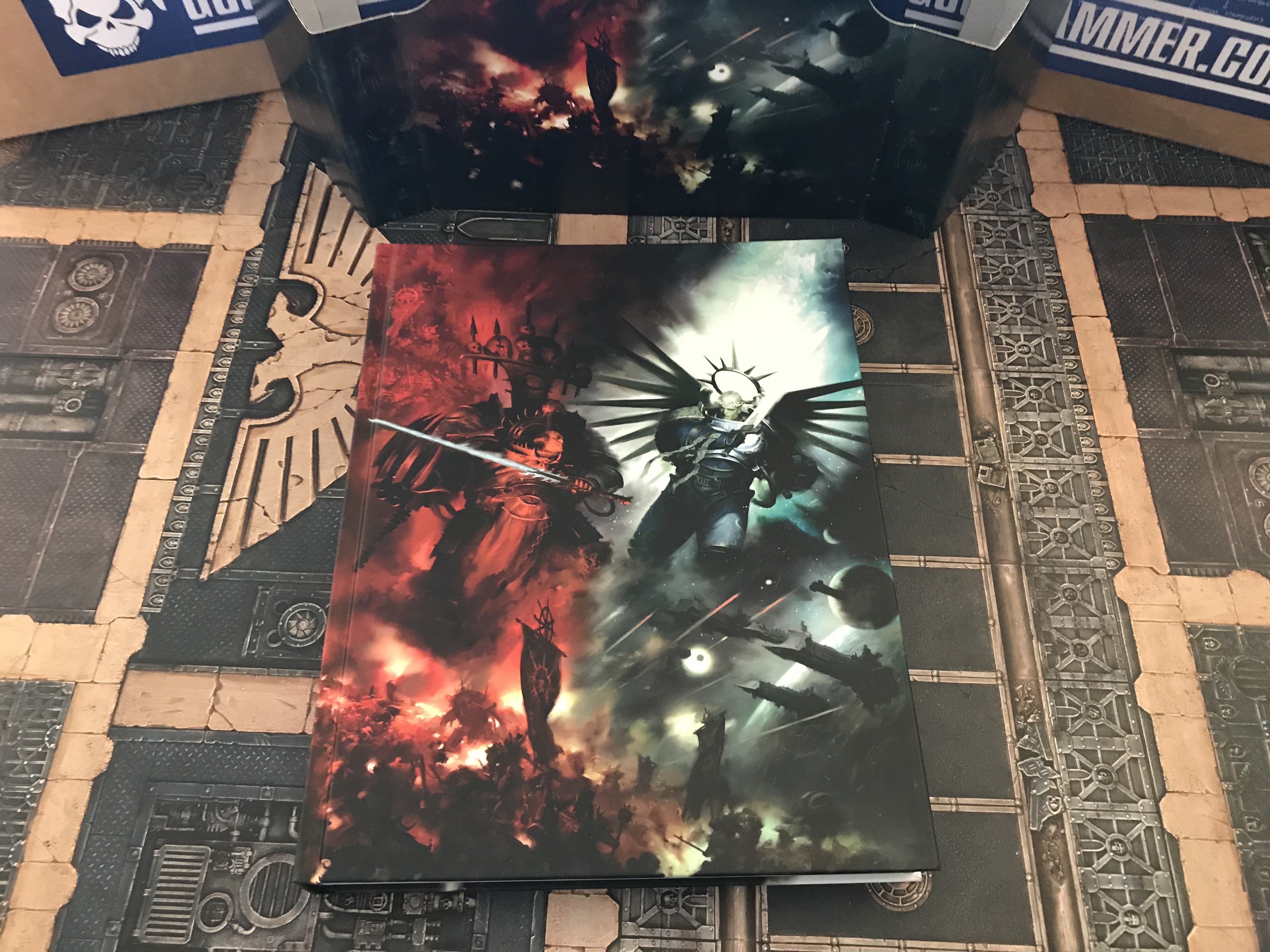For a large part of our audience, the number one, burning question about the new edition of Warhammer 40K is a simple one – are the rules good?
Fundamentally yes! In terms of core quality they’re the best they’ve ever been and they shape the game into something that looks like it’s going to be a blast to play. There are a few things I’m a little less hot on, but our overall impression is extremely positive, and today I’m going to dig in to why.
I’ve touched on it a few times, but one of the things that got me back into this game in 8th after a long time away was how clever and well thought out the core rules seemed when I had a look at them. They convinced me to get my models out of their boxes and try some games, and those games were good enough that, well gestures at this whole thing.
The rules of 9th edition represent both a substantial refinement of 8th’s core engine and I think also a fairly major shift in emphasis of how the game plays on the table – one that I am fundamentally on board with. The new edition is going to be an exciting new world, and one I can’t wait to start properly getting into, Covid permitting.
Obviously with an entirely new edition, there’s an absolute tonne of stuff to cover – and this article isn’t going to be me attempting to go through every change. That’s going to be covered by Ruleshammer, where Rob Chilton is going to be going through the rules phase by phase looking at what’s changed (with occasional input from yours truly and other guests to highlight competitive impacts). This article is intended to be a review of what the rules cover, how they’re presented, and what they might mean on a macro level. This isn’t going to be our final word on any of this – the whole competitive team is hard at work producing a roundtable on the impacts of the changes on tournament play, while missions are also going to get their own article, as there’s a lot to unpack there! You can see more detail of when all this is coming in our 9th Edition content schedule, and we’ll have a landing page going up on Monday.
With all that out of the way let’s get into it!
Overview
The 9th Edition rulebook substantially expands the space given over to rules compared to 8th, and is much more practical about what’s required to play a game of 40K. Rather than having a core rules section and then banishing terrain, army building and core missions structure to separate parts of the book, there’s now a massive 80-page section just called “the rules” that contains all of this, with separate sections outlining the specifics of Open Play, Matched Play and Narrative/Crusade mission packs following on. There’s also a Rules Appendix, which contains lists of Blast Weapons and Aircraft, details of how certain types of rules interact in a Rare Rules section and, as a final nice surprise, a Glossary that defines a huge number of game terms.
Within “The Rules”, the content can be roughly divided into:
- Basic Rules, outlining the fundamentals of game terms and how each phase works. These are also available in the Core Rules PDF released on Thursday.
- Army Construction, detailing how you put together a battle forged army using either power level or points, and how that dictates the command points available to you.
- Rules for use during missions, including stratagems, reserves, actions and the basic structure of missions.
- Terrain, covering uh…terrain. Buildings and stuff. Trees maybe.
Good rules are fundamental to a good game, and it’s great to see them get the space they need to really shine. Once you add on the sections for the types of game and the appendixes very close to half of this massive book is rules, and that’s a win from me – less isn’t always more when it comes to rules writing, as the accumulation of vital FAQs in 8th clearly demonstrated.
Presentation
That’s a good theme to kick off our next section – how the rules are written and presented. Basically – really, really well.
Rule Structure
Before going anywhere near talking about the phases of the game, the rules start out with six pages explaining core concepts, and then a double page spread on reading datasheets. This is all presented (as all the rules are) in an extremely clean and precise manner – each individual rule is given plenty of space on the page, and is split into two parts – a text body that covers the full detail, and a bullet pointed summary at the end.
This is a great choice, as it covers the needs of all players. There has been a reasonable amount of joshing online about how wordy some of the rules we’ve seen have been, but some amount of wordiness in the main rules is necessary, because unless they make it clear how they apply in the vast majority of situations, future FAQs beckon. The tradeoff for this is that referring to a rule becomes a bit more of a pain, but that’s where the bullet points come in – once you’ve read a rule once, you probably don’t need to refer to the text body unless you’re trying to clarify an edge case.
It’s further helped by the fact that in general, the rules also now do what you would reasonably expect in any given situation, and you’re unlikely to get caught out too badly by assuming the bullet points tell you a pretty accurate story. Finally, for the occasional rule where there are still ambiguities in the main body, a glance at the bullet points can sometimes help – there’s at least one place where a sentence could be read in two possible ways, but the summary makes it incredibly clear which one is correct.
It’s also worth highlighting that all the way through the core rules, things that used to be “matched play restrictions” are now part of the core ruleset. This helps make sure everyone experiences the game the same way, and fixes the weird paradox from 8th that some of the min-maxed nonsense you could pull off in narrative play was way worse than what matched play let you get away with. Adopting the concept that any mode of playing a strategy game should be “basically fair” gets a big thumbs up from me!
The Content
With that, let’s return to the core concepts. This goes through a lot of stuff that ended up having to be exhaustively FAQed last time around (things like “wholly within” vs “within”) to make sure that before going into the way a turn plays out a reader has the basic constraints down. This is also where some of the impactful changes kick off right away, as you can see in today’s Ruleshammer.
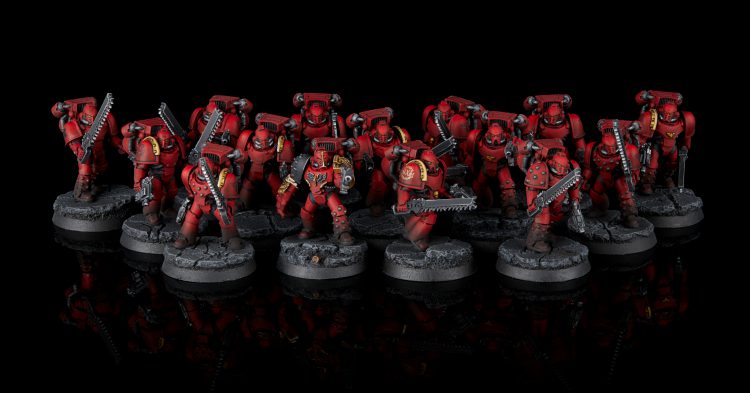
From there, the rules move into the familiar tour through the phases of the game, and along with Core Concepts these are the bits that you can largely see replicated in the Core Rules PDF (though interestingly it isn’t a direct lift of the pages like in 8th, it’s been reformatted). Each phase has a nice big summary of how you play through it, and the rules are largely laid out in a sensible order. Structure wise, there are some good changes too – Reinforcements being its own step separate from “at the end of the movement phase” has been desperately needed for a while, and subtle things like making “Remain Stationary” an explicit action that units do when they don’t move supplies the writers with a much more consistent set of terminology to use elsewhere.
Outside of the phases, the ordering of the rules is a little bit more haphazard – as soon as phases are up you get a page on mission structure and the steps for playing one, but unless you are literally playing the one open war mission in this section the steps don’t do anything, as each mission set later on has its own laid out series of steps that both replicate and modify a lot of what’s here. After that we go through:
- Building an army
- Stratagems
- Reserves
- Actions
- Terrain
I’d have probably put the sample mission itself at the end – while I can see the logic that the mission introduces some of the other concepts, I think they largely stand on their own, and understanding how an army is constructed and how you populate a battlefield first would be better. Also, at that point, you could just segue straight into Open Play, as long as you combined the stuff about Objective Markers with Actions (which I think would make sense, since they often interact).
Realistically this is nitpicking and we now return to the main point of this section which is gushing about stuff. Army building is massively better presented than 8th’s, which never really recovered in comprehensibility from the counter intuitive goal of using as many detachments as possible. I also like them finally making a hard and fast call about what goes on your army list (make sure not to skim over the “Battle-Forged Army Roster” page). Adding more generic stratagems is extremely good, and Actions are the best kind of rule in that they do nothing but open up design space, top marks.

Finally, we have terrain. The new rules look awesome and I’m very excited to play with them, but they are also the place where the clarity breaks down just a little bit – of the things we’ve been a bit unsure about in our discussions, the vast majority come from these pages, and I think the split responsibilities between terrain categories and terrain traits are the main culprit. In order to understand fully what rules a terrain feature has and when they apply you need both the rules for its category and for its traits, so you need to flip back and forth to work this out. These pages would have massively benefited from some examples showing exactly how this works in practice, and while I’m sure they’ll be second nature soon enough, it’s a weird miss – especially as this is a place where some of the confusion could easily have been fixed with examples. Poor choice of examples does pop up in a few other places to – it boggles my mind slightly that none of the examples for Blast weapons cover multi-dice shot numbers, as that was basically the first question on everyone’s lips when they were announced and still the subject of hot debate.
It’s a shame to end this section on that slightly downer note and I don’t want it to take away from the overall achievement here – the rules are easily the clearest and most comprehensible they’ve ever been. The first read through is going to take people a bit longer, but the payoff for that is going to be a much more seamless experience in your early games, and less of a requirement to have 20 pages of FAQs loaded up on your tablet for emergencies.
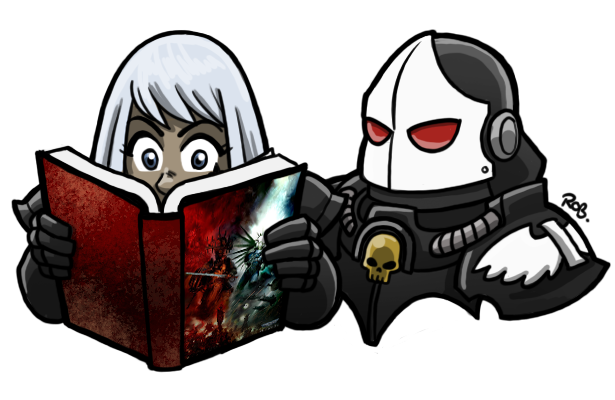
How they Shape the Game
Big changes are here. As the rules previews for 9th dripped out, few individual things (at least in the early stages) looked like they were going to massively change the game, but once everything is taken together this book represents a significant upheaval of our favourite game, aimed squarely at solving 8th Edition’s most fundamental problem, and in doing so substantially shifts the focus of competitive play.
What Was Wrong With 8th Edition?
A huge tension festered at the heart of the previous edition in a way that would make Papa Nurgle proud – it basically contained two games. One, enjoyed by the vast majority of the world’s players, took advantage of the immense simplification drive that went into launching 8th to play quicker and easier games of 40k than ever before. The other, more commonly seen on tournament tables, found all the places where 8th’s rules let you squeeze the highest performance out of your units while shutting down as much of your opponent’s agency as possible to play some incredibly cut-throat games using tactics almost unrecognizable to players from the first group.

Now I realise that a decent chunk of our audience is in the second group there and hey, so am I. I have enjoyed 8th edition immensely, pile-in tricks, daisy chains, wraps and all – but I’m not about to pretend it was either how the game was intended to be played nor especially healthy in the long run, for three key reasons.
- New rules were squarely aimed at the first style of game, and would very often introduce terrible, exploitable gaps for players pushing the limits.
- The experience for newer players trying to break into competitive play or a more casual player coming up against a competitive one was often horrific – losing a game to poor strategy is one thing, but getting dumpstered in a way that barely even matches your prior understanding of how the game works isn’t fun.
- A lot of the high-end strategies focused on shutting down the opponent’s agency, which had a knock on effect on design space.
The last point is really the key one, and the first two at least partially flow from it. Have a think about the stuff that’s really iconic from high-end 8th edition, and a common thread is using the rules to shut down your opponent’s ability to do anything. Armies full of powerful characters sitting behind a few impregnable screens. Rolling wraps that stop your opponent ever getting a chance to shoot. Daisy-chained hordes occupying two thirds of the board while still enjoying the benefits of three auras. Armies that are basically all planes denying melee forces a chance to play.
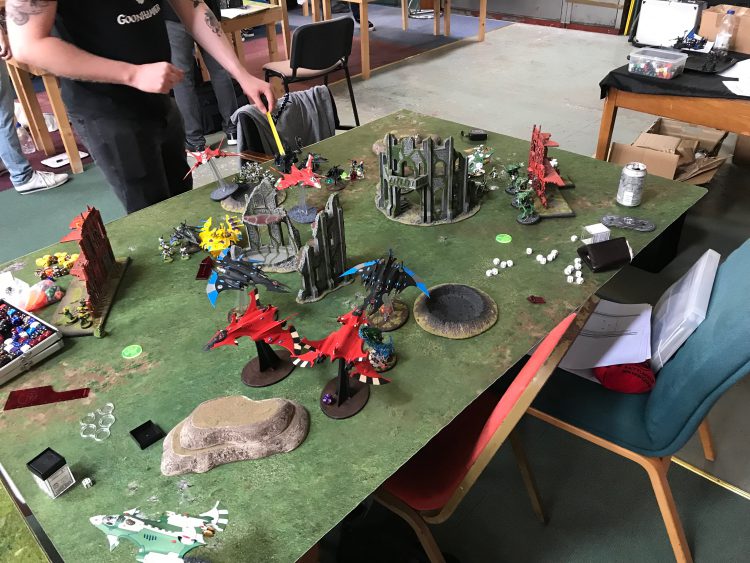
All of this created some interesting strategic and metagame tensions for the players who bought into it (and goodness knows it was fertile ground for producing strategy articles), and made the skill ceiling of the edition pretty high, but it could also make losing games a pretty dismal experience, and created massive gatekeeping effects both in terms of players getting into it and on what proportion of units and rules were truly viable at the top end. For the very best lists, it wasn’t enough for a unit to be pretty decent at its job – it had to be fantastic, because the goal was either to smash through whatever wall of nope your opponent was going to throw up or implement your own strategies to seize the reins of the game.
Often enough, people’s nonsense cancelled out sufficiently that you got some great games, and competitive 8th was great fun – but I don’t think it would be unreasonable to say that it was kind of accidental.
How 9th Changes It
9th sets out to change that – it’s very clear that the designers have a goal for what they want the game to look like, and a clear enough understanding of how their choices affect the game to make a real attempt to work towards it. That goal is a pretty simple one – they want everyone’s experience of the game to be much more unified than it was in 8th, and the tactical focus to be on the smart, strategic use of units, not on shutting out your opponent’s options.
My list of examples of common tricks seen in 8th wasn’t random. Every one of them has some sort of targeted change in 9th that dials back their power. Characters still have protection, but it’s limited and breachable by a determined opponent. Rolling wraps and other combat tricks are made harder by changes to charges and the breakout stratagem (you now need to tri-point two enemy units to properly lock them down). The Air Wing is dead (good riddance) so there’s only so hard you can skew towards planes. Hordes get the triple whammy of harsher coherency rules, blast weapons and reduced ability to get attacks in combat (though do gain a bit in morale).
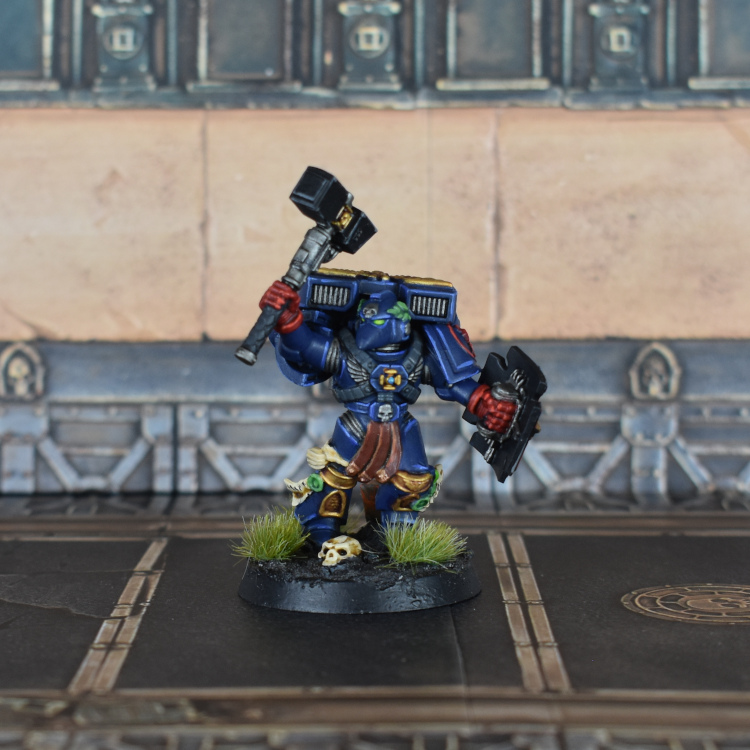
None of these things stop being usable, and top players are still going to find ways to make things do good work, but all of them are less powerful, and critically they’re weaker because it’s harder to totally control a game with them. It also tends to close out ways where a single unit can egregiously overperform in some situations with clever micromanagement, and generally makes units perform more in line with how you’d “expect” them to on the table.
Reducing the impact clever tricks and individual units can have on the game puts the focus for winning much more squarely on good, balanced list design and clever strategic use of your units. Getting your target priority and overall army movement right is going to be hugely important to success, especially as it’s no longer going to be so trivial to try and take over the whole board. 8th’s character targeting and strung out hordes made controlling the entire table a reasonable goal in a game where you had pulled ahead, but now that lone characters aren’t an 18” diameter bubble of “nothing much happens here” and your bigger units have to stay more bunched up, that isn’t nearly as reliable – staying safe or forging out to claim objectives is going to be a real decision.
I also think this opens up design space – the obstacles to a unit or rule getting to do something cool on the battlefield are considerably smaller, and it’ll be way harder to completely shut down an opponent who’s trying something out-there with sub-optimal units. Good play is still going to be rewarded, and the top players will thrive as they always do, but the way they’re playing the game will be much more recognisable as an ascended version of what everyone else is doing, not its own weird thing that the rules kind of tolerate.
The Risks
I’m a fan of the intent here and am keen to get some games in, but it does come with risks as well. Getting the numerical balance on units right becomes more important than ever, because all the janky 8th edition tricks had a secondary purpose in providing a tool for a player who had a bad start or was low on materiel to pull back into the game. Without that as a comeback mechanism you need to make sure that alpha strikes aren’t so preposterously destructive as to leave the second player out of the game.
The other thing you need is good missions, and while we’re going to look at them separately, my high level take on them is that I’m not quite convinced. I do think the substantial changes in how the dynamics of positioning play out mean that they need a fair shake on the tabletop to properly assess, but my current expectation is that my concerns will be borne out rather than allayed. Saying that, they’re definitely at least fine and GW have now announced a separate GT mission pack as a product coming out alongside the main release, so I’ll wait and see what’s in there for sure!
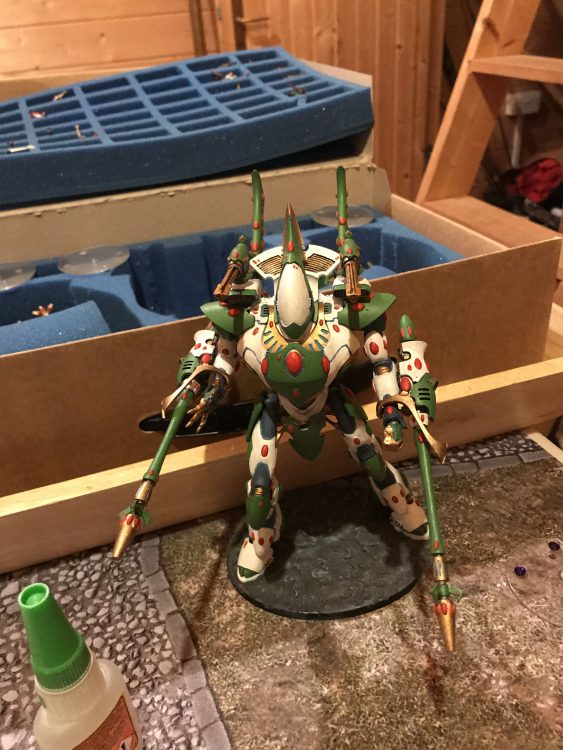
I guess the other points of mild sadness are the decision to lock pre-game choices onto army lists, and the weird two-tier status of solo Lords of War. With list choices I get it, and I’m happy we at least have a consistent call, but where a lot of what has changed here opens up design space, this closes some of it down, as it massively weakens “niche” warlord traits, relics and psychic powers. That’s another thing that might be different in the GT pack I guess! Lords of War I’m assuming is something that’s going to get sorted out as new codexes roll out, but at the moment you get “good” rules if you want to take either a full Knight detachment or one of the Primarchs and awful rules if you want to take anyone else. RIP my largest, tallest son. For now.
Do I Like It?
Genuine though these concerns are, I’m massively reassured overall by the sense of purpose and intent that drives everything – because it makes me think that even if the concerns are valid they won’t be left untreated. GW have reacted more and more quickly to issues over the course of 8th Edition, and with 9th in the hands of a team who know what they want to achieve, know how to write rules to accomplish it, and are plausibly empowered by the much hyped app to take more dynamic action to address issues, I’m pretty confident we’re in for a good time.
I do think there’s might be some real backlash in the competitive scene in the short term once players have processed what all this means – a lot of the skills that made you “good at competitive 8th” see a reduction in emphasis, and we’re all going to have to re-learn how to eke out an advantage in our games. If I had to recommend which of our back catalog of strategy pieces to look at, it would be the macro-level ones rather than the pieces covering low-level technical play – that’s certainly where I’m planning to prioritise updating our guides.
I think any backlash will be exacerbated initially by the missions having some balance issues, and I hope that if those do prove to be an issue a fix comes quickly, because I think the core rules enable great missions and it would be a tragedy to see the edition fall down on that. As I said above, I think we’re now in a world where GW are genuinely invested in the success of the tournament scene, so I’m optimistic that any flaws will be resolved, but I can’t pretend that my enthusiasm isn’t tempered by just a tiny bit of nervousness.
Wrap Up
9th Edition’s rules are the best they’ve ever been, and that means that on day one of the edition we’ll be playing a game of a quality that it took several years of brutal FAQing to kick 8th into being. It isn’t perfect, but one of the things that I find encouraging is that the areas I’m slightly skeptical are the ones that are easiest to iterate on or improve – ultimately if the missions turn out to be a bit sub-par then a future set can improve them. I can’t wait to start playing games, and am feverishly waiting for the points updates so I can start list-crafting for my first few, and will of course be feeding my impressions back here as I get more games under my belt. In the meantime, don’t miss out on our Ruleshammer deep dives as we look at the key changes across the phases of the game.
Finally, as ever, if you have any comments, questions or suggestions then hit us up at contact@goonhammer.com.
